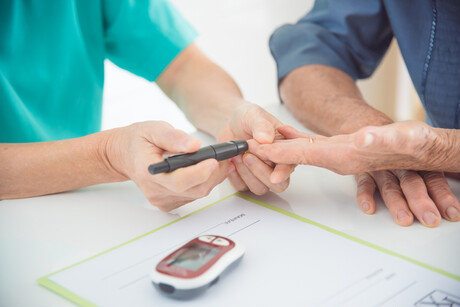A new electronic sock is designed to detect unhealthy walking style, which is linked to diabetes and poor circulation.
Around one in ten people – 537 million in total – suffer from type 2 diabetes worldwide1This means they have a two to four times higher risk of coronary heart disease, stroke, heart failure, atrial fibrillation and peripheral arterial disease compared to their healthy peers.2
“Diabetes can affect the way people walk, also called gait. Patients with diabetes tend to put pressure on the metatarsal area of the foot rather than the heel. This type of walking promotes ulcers that can become infected and lead to amputation. “Early detection of walking problems using an electronic sock would allow patients to learn a healthy walking style and prevent serious foot problems,” said study author Dr. Ki Hong Lee from Chonnam National University Hospital in Gwangju, Republic of Korea.
Researchers hope the sock will help improve the prevention of foot ulcers and amputations, benefiting patients with diabetes who suffer from clogged arteries in their legs. The results of the project were presented at EHRA 2024, a scientific congress of the European Society of Cardiology (ESC).3
BCG monitoring
The study examined whether a sock equipped with a ballistocardiogram (BCG) sensor could distinguish between healthy people and patients with diabetes. A BCG detects body movement as the heart expels blood and could potentially be used to measure heart rate and the pressure exerted on the feet while walking.
The researchers recruited 20 patients with diabetes and 20 without diabetes. All participants wore the BCG sock for 40 seconds while standing and 40 seconds while walking to measure heart rate and assess foot pressure distribution. At the same time as wearing the sock, participants had an electrocardiogram (ECG) to measure heart rate using a small patch placed on the wrist and a single electrode on the chest. The ECG is the gold standard for measuring heart rate in cardiology.
The purpose of the heart rate measurement was to assess the accuracy of the BCG sock as a measurement tool compared to the ECG. For this analysis, the ECG values of each study participant (patients and controls) were compared with the BCG values of the same participant. The researchers found that the heart rate measurements from the BCG sock and the ECG were almost the same, with a correlation coefficient of 0.99 (95% confidence interval 0.99-1.00).
Foot pressure distribution
The foot pressure distribution measurements were taken to find out whether the BCG sock could detect differences between patients with diabetes and healthy controls and differences between patients with diabetes depending on whether or not they had nerve or blood vessel damage. Nerve damage was classified using the Michigan Neuropathy Screening Instrument (MNSI), while blood vessel damage was classified using the Ankle Brachial Index (ABI).
The BCG comparison between patients and healthy controls showed that patients with diabetes exerted higher pressure in the metatarsal area of the foot when walking than participants without diabetes. When comparing BCG between patients with diabetes, researchers found that those with blood vessel damage (ABI score less than 0.9) experienced significantly greater pressure on the midfoot area compared to patients without blood vessel damage (ABI score of 0.9 or higher). exercise of the foot when walking and less pressure on the heel. There was no significant difference in foot pressure distribution measurements between patients with and without nerve damage.
Lee said: “The novel BCG sock provided accurate measurements of heart rate, indicated by almost identical readings to the ECG. The pressure measurements showed that the sock could identify patients with diabetes and also locate patients with diabetes and poor circulation. “In summary, the results suggest that the electronic sock could be a simple, non-invasive way to identify patients with diabetes who could benefit from gait training to prevent foot complications.”
1. International Diabetes Federation. IDF Diabetes Atlas: https://diabetesatlas.org/.
2. Marx N, Federici M, Schütt K et al. 2023 ESC guidelines for the treatment of cardiovascular disease in patients with diabetes. Eur Heart J. 2023;44:4043–4140.
3. The abstract “Wearable self-powered ballistic signal detectors with ferroelectric composite arrays for cardiovascular and diabetic complications” will be presented during the “Basic Science 1” session taking place on April 7, 2024 at 5:30 p.m. CEST at Moderated ePosters 1 .
